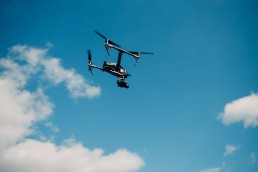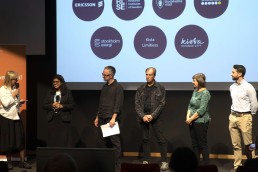When Sweden’s photonics sector recently gathered in Kista for Optics & Photonics in Sweden (OPS), one theme dominated – defence. The conference demonstrated how light-based technology is rapidly becoming a cornerstone of Europe’s security capability.
Behind every drone, every satellite and every secure communication link, light is now becoming a strategic necessity. But what makes photonics so vital to modern defence, and what positions Sweden as a strong contributor?
The photonic advantage in modern defence
Photonics – the science of how light can be controlled and applied – makes it possible to create systems that are faster and more efficient than traditional electronics. When combined with semiconductor technology, information can be transmitted more quickly, with lower energy consumption and higher precision.
Concrete applications include infrared sensors and LiDAR systems that detect drones and missiles long before they appear on conventional radar. Optical communication links enable secure, interference-free data transfer, and in the future, quantum photonics will open the door to unbreakable encryption and even more advanced detection systems.
A Swedish ecosystem for innovation
In Sweden, a complete photonics ecosystem has emerged, bringing together research, innovative startups and international industry. Each category contributes to the nation’s technological sovereignty and defence readiness:
Sensor and Imaging Technology
- IRnova – Develops advanced infrared detectors extending the range and precision of surveillance and targeting systems across air, land and maritime domains.
- Teledyne FLIR – Delivers multispectral and thermal imaging systems for drone detection, target tracking and battlefield monitoring, enhancing situational awareness.
Semiconductor and photonic integration
- Mycronic – Provides world-leading photomask writers and die-bonding equipment used in the manufacturing of next-generation photonic and semiconductor chips, ensuring secure and traceable European production capacity.
- Silex Microsystems – Operates one of the world’s most advanced MEMS foundries, producing miniaturised sensors and actuators critical for navigation, guidance and environmental sensing in modern defence systems.
Laser and optical systems
- Lumibird Photonics Sweden – Supplies high-performance laser rangefinders and designators for naval, airborne and ground applications, contributing to precision targeting and autonomous systems.
Together, these companies, along with coordinative initiatives like Semiconductor Arena in Kista Science City, form the basis of a national value chain where research becomes production – and production becomes operational capability.
From policy to capability
Transforming innovation into defence capability requires coordination. Photonics, as the optical backbone of next-generation chips, represents the intersection where Sweden’s strengths in defence innovation meet Europe’s semiconductor ambitions.
“Over the past year, we’ve noticed a clear increase in openness and curiosity from both defence organisations and their industrial partners. It’s not just about scouting new technology anymore – it’s about understanding what Swedish deep-tech companies can bring to the next generation of systems,” says Peter Tiberg, Chief Product & Commercial Officer at Polar Light Technologies, a Swedish startup at the forefront of MicroLED development. “For us, this means focusing on building trust through transparency, reliable delivery, and long-term commitment rather than quick pivots.”
Within the framework of the EU Chips Act and a broader ambition for strategic autonomy, Sweden contributes its expertise to the shared defence goals of the EU and NATO. Standardisation and cooperation strengthen interoperability, allowing allied systems to share both materiel and data.
Sweden’s Minister for Defence, Pål Jonsson, has emphasised the strategic link between semiconductors and national security. At the core of this lies Europe’s common need for technological sovereignty – and to secure knowledge and production capacity within the Union’s borders.
The time is now
A global race is underway, as nations invest heavily in semiconductors and emerging technologies such as photonics. Sweden is uniquely positioned, with expertise across the entire value chain – from laboratories and test facilities to companies that have advanced optical science for decades.
“Right now, enormous amounts of money are being poured into the market,” says Raoul Stubbe, Deep Tech Business Coach and Co-founder at Sting. “It creates opportunities for new actors to take their place. But once the funds are locked into long-term projects in Sweden and NATO, the window for new initiatives will close.”
The Swedish ecosystem already has all the pieces in place to succeed in combining light (photonics) with logic (semiconductors) and defence. The next step is increased coordination between actors at all levels throughout the chain, from research and production, and ultimately military capability. To secure a strong position, we need the determination to act together – before others do.
Do you want to get involved? Reach out to hanna.eldh@kista.com
–
Semiconductor Arena is co-funded by the European Union and Region Stockholm, and is run by Kista Science City, KTH, RISE and Sting.
Related Articles
October 29, 2025
Integrating drones into city life: Stockholm takes next step
The boundaries of conflict are shifting. Today, national security isn’t just…




